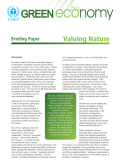This guide aims to encourage early dialogue and diagnosis in and by developing countries on what a green economy would mean for their country. Green economy and green growth are hot topics. Definitions, evidence, debates and increasingly, policies, have tended to be dominated by powerful countries and international groups. Several intergovernmental organisations are making it a priority and are announcing policies and programmes; but they each have different approaches. This proliferating work on the international scene provides rich material which can be highly influential in developing countries. However, there are risks of considerable bias if the concepts are not first explored by stakeholders in-country. As the 2012 Rio+20 United Nations Conference on Sustainable Development concluded, green economies should take very different forms according to a country’s diverse capital endowments and needs. As such, green economic policy and investments need to be tailored at both national and local levels.

At a more fundamental level, healthy ecosystems represent the foundation of economic activity and a prerequisite for achieving a green economic transition. Given this, it is essential that the economic value of these services are recognized, demonstrated and captured in the accounts and decision-making of governments, the private sector and consumers
The financing required for a green economy transition is substantial, but it can be mobilized by smart public policy and innovative financing mechanisms. Supportive public finance and policy, the growing green orientation of capital markets, and the evolution of emerging market instruments are opening up the space for large-scale financing that will bolster national initiatives to green economies. But these flows are still small compared to total volumes, and urgently need to be magnified for the transition to be successful in the near-term.
This is the third edition of Dual Citizen’s annual Global Green Economy Index (GGEI), an analytic tool designed to help governments, international organizations and investors improve their “green” branding and communications strategies. This report provides an overview of the 2012 analysis of the GGEI. The GGEI measures perceptions of green reputations of 27 selected countries as judged by hundreds of expert practitioners and benchmarks these against a green economy performance index. These 27 countries represent over 90 per cent of the international green economy.
The green growth concept has both strategic and analytical merit. It has strategic merit by turning a negative debate about a costly constraint (on emissions) into a narrative about potentially attractive opportunities. Authors like Barrett believe that this might change the dynamics of the international negotiations.
Analytically, green growth applies a new, richer and more diverse set of economic tools to a burning issue. This has implications on policy design. The ‘green growth’ narrative reinforces, rather than diminishes, the need for collective action. The economic opportunities that green growth may bring do depend on a joint understanding by a sufficiently large number of players that this is the way to go. This makes green growth a classic collective action problem.
